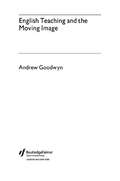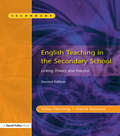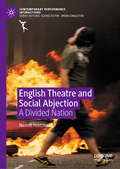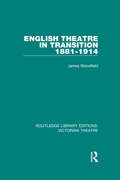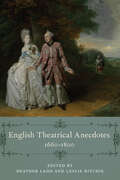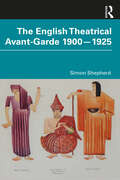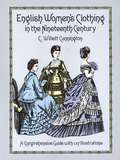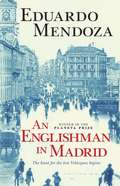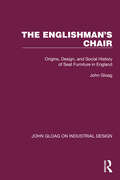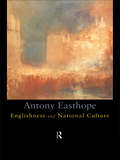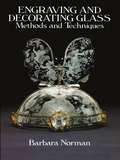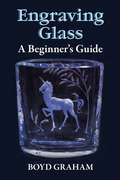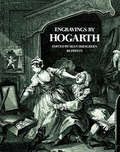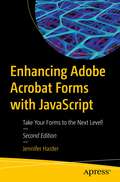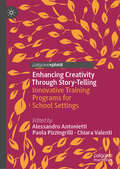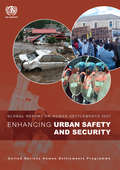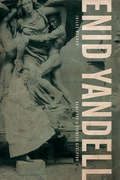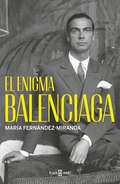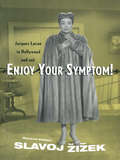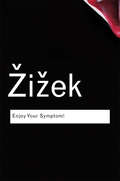- Table View
- List View
English Teaching and the Moving Image
by Andrew GoodwynAndrew Goodwyn's straightforward approach to teaching about the moving image de-mystifies this topic and shows how it can be easily incorporated into classroom practice. The first of its kind, this book builds on teachers' knowledge of teaching about advertising, newspapers and visual adaptations of literary texts, and provides practical advice and guidance on: * Adaptations: not just the film of the book* Teaching film* Teaching television* Practical work* New technologies and the moving audience. This jargon-free book will be a stimulating and useful guide to teachers and student teachers looking to improve their knowledge of the moving image and its recent arrival in secondary school teaching.
English Teaching in the Secondary School 2/e: Linking Theory and Practice
by Mike Fleming David StevensPresenting an informed view of current educational policy, this text encourages students of secondary English to take a creative and independent interpretation of government initiatives in order to achieve effective teaching practice. It provides a good balance of theoretical material with practical ideas for application in the classroom and strongly encourages reflection and critical thought. This new edition includes: coverage of the National Curriculum 2000, the National Literacy Strategy and the new Key Stage 3 Strategy a new chapter on how to teach ICT a new chapter on Inclusion – including differentiation, cultural diversity, EAL and teaching across the ability range new material on how to teach Shakespeare an introduction to cross-curricular themes – such as citizenship, and social, moral and spiritual values. Written in an accessible and conversational style, this text poses an excellent degree of challenge for all students on initial teacher training courses.
English Theatre and Social Abjection: A Divided Nation (Contemporary Performance InterActions)
by Nadine HoldsworthFocusing on contemporary English theatre, this book asks a series of questions: How has theatre contributed to understandings of the North-South divide? What have theatrical treatments of riots offered to wider debates about their causes and consequences? Has theatre been able to intervene in the social unease around Gypsy and Traveller communities? How has theatre challenged white privilege and the persistent denigration of black citizens? In approaching these questions, this book argues that the nation is blighted by a number of internal rifts that pit people against each other in ways that cast particular groups as threats to the nation, as unruly or demeaned citizens – as ‘social abjects’. It interrogates how those divisions are generated and circulated in public discourse and how theatre offers up counter-hegemonic and resistant practices that question and challenge negative stigmatization, but also how theatre can contribute to the recirculation of problematic cultural imaginaries.
English Theatre in Transition 1881-1914 (Routledge Library Editions: Victorian Theatre #6)
by James WoodfieldOriginally published in 1984. The turn of the nineteenth and twentieth centuries was a time of considerable change in the English theatre. Victorian attitudes were shocked or shattered by the new drama of Ibsen; the major figure of George Bernard Shaw dominated the period; theatre censorship was the subject of a long and furious contest; and staging conventions changed from the spectacular stylings of Irving and Beerbohm Tree to the masking and statuesque styles of Isadora Duncan and the inner realism of Stanislavsky. This book traces the activities of the leading figures in the English theatre, notably William Archer who introduced Ibsen to this country and who became one of the main promoters of the idea of a National Theatre. Other personalities discussed include Harley Granville Barker, particularly his association with Shaw at the Court Theatre and his part in campaigns against censorship and for changes in the staging of Shakespeare, and Edward Gordon Craig, whose rebellion against the Victorian theatre took and anti-realist direction. This is a stimulating account of the background to the modern English theatre which can only increase appreciation of its standard and variety.
English Theatrical Anecdotes, 1660-1800 (Performing Celebrity)
by Leslie Ritchie Máire MacNeill Heather Ladd Chelsea Phillips Nevena Martinovic Michael Burden Fiona Ritchie Seth Wilson Elaine McGirr Amanda Weldy Boyd Danielle BobkerThe essays in English Theatrical Anecdotes, 1660-1800 explore the theatrical anecdote’s role in the construction of stage fame in England’s emergent celebrity culture during the long eighteenth century, as well as the challenges of employing such anecdotes in theatre scholarship today. This collection showcases scholarship that complicates the theatrical anecdote and shows its many sides and applications beyond the expected comic punch. Discussing anecdotal narratives about theatre people as producing, maintaining, and sometimes toppling individual fame, this book crucially investigates a key mechanism of celebrity in the long eighteenth century that reaches into the nineteenth century and beyond. The anecdote erases boundaries between public and private and fictionalizing the individual in ways deeply familiar to twenty-first century celebrity culture.
The English Theatrical Avant-Garde 1900-1925
by Simon ShepherdThe English Theatrical Avant-Garde, 1900–1925 unearths an extensive range of hitherto forgotten or ignored theatre practices. In doing so it reveals some of the well-known figures of the early twentieth-century English theatre in a strikingly new light. It fluently describes an intensity of innovation and experiment that together made the Edwardian theatre rather more radical, and rather more queer, than we’ve ever thought. Where the majority of writing on the early twentieth-century theatrical avant-garde is concerned with European movements and experiments, English activity of the period is often seen as parochial and conservative – mainly realism and issues-based drama. This book presents a new model of how avant-gardes might work; a model based not on masculine individualism but on communal inclusion. In describing this fascinating material, the author introduces us to many new figures and shows familiar ones in different ways: there’s Florence Farr, independent woman; Bob Trevelyan, radical pacifist and music drama pioneer; Granville Barker doing fairy plays while de-dramatising drama; Laurence Housman, socialist, homosexual, scripting St Francis; and the oddly modern J.M. Barrie. Together they made theatre practices rich in their diversity but consistent in their attempt to be new, producing a theatrical avant-garde unlike any other. This is a vital and indispensable new study for scholars and students of early twentieth-century theatre in England and beyond.
English Women's Clothing in the Nineteenth Century: A Comprehensive Guide with 1,117 Illustrations
by C. Willett CunningtonThe nineteenth century was a period of continuous change for women's clothing in England. The growing prosperity of the merchant class meant an ever-larger number of women for whom "dress" was a principal function in life, while the increasing availability of lower-priced ready-made garments enabled women of moderate means to purchase the fashions of the day. In addition, the development of the railways spurred the spread of new goods, while the removal of the tax on papers in 1854 produced an abundance of fashion magazines at cheap prices, bringing news of the latest styles to the multitudes.The magnificent array of ladies' fashions that characterized the century are on display in this remarkably complete decade-by-decade overview. Drawing almost exclusively on contemporary sources — fashion magazines, newspapers, rare period photographs, memoirs, Victorian novels, periodicals, and other publications, as well as firsthand observation of actual garments — the author describes and explains the couture that evolved in response to changing social conditions, technological innovations, and cultural developments.Over 1,100 line and tone drawings and photographs depict hundreds of outfits ranging from lovely morning dresses and starkly attractive riding outfits to elegant carriage costumes, opulent evening dresses, and exquisite bridal gowns. Full-page plates also depict period millinery, footwear, underclothing, and other apparel, while three useful glossaries provide descriptions of materials, definitions of technical terms, and more.Museum curators, vintage clothes collectors, and fashion historians will find this carefully researched and well-written book an indispensable tool for dating, identifying, and authenticating vintage clothing. Not only are styles described and illustrated in detail for each year; all the small details of construction by which specimens can be dated are given wherever possible. Moreover, designers, illustrators, and fashion enthusiasts will be delighted by the superbly detailed illustrations, which painstakingly document the fashionable finery of the Victorian era.
English Wood-Engraving 1900-1950
by Thomas Balston"A wonderful look at the many styles of wood engraving from the time period 1900–1950. The illustrations are sublime, and there is a lot of variation both in theme, execution and style. I really enjoyed looking at the engravings, and the text was interesting and very readable." — Jefferson-Madison Regional Library SystemAt the turn of the twentieth century the art of wood-engraving enjoyed a flourishing revival among English artists. These works were so fundamentally different from their predecessors, in both design and technique, that they formed a new branch of the art. This volume showcases five decades' worth of magnificent wood engravings in a series of finely wrought black-and-white and color images, selected from a wide array of sources that includes lesser-known works from temporary exhibitions and limited editions.An informative history of the art precedes the illustrations, tracing the development of wood-engraving from the art form's earliest days through its decline and resurgence of popularity. A chronological presentation of striking, intricately detailed images follows, featuring the works of such noted artists as Eric Gill, Iain Macnab, Eric Ravilious, John Nash, and Clare Leighton, in addition to scores of others. Ranging from vignettes of animals and rural life to street scenes, portraits, and episodes from literature, this survey offers a magnificent overview of the vibrant era in the art of wood-engraving.
An Englishman in Madrid
by Eduardo MendozaAnthony Whitelands, an English art historian, is invited to Madrid to value an aristocrat's collection. At a welcome lunch he encounters José Antonio Primo de Rivera, founder and leader of the Falange, a nationalist party whose antics are bringing the country ever closer to civil war. The paintings turn out to be worthless, but before Whitelands can leave for London the duque's daughter Paquita reveals a secret and genuine treasure, held for years in the cellars of her ancestral home. Afraid that the duque will cash in his wealth to finance the Falange, the Spanish authorities resolve to keep a close eye on the Englishman, who is also being watched by his own embassy. As Whitelands - ever the fool for a pretty face - vies with Primo de Rivera for Paquita's affections, he learns of a final interested party: Madrid is crawling with Soviet spies, and Moscow will stop at nothing to secure the hidden prize.
An Englishman in Madrid
by Eduardo MendozaAnthony Whitelands, an English art historian, is invited to Madrid to value an aristocrat's collection. At a welcome lunch he encounters José Antonio Primo de Rivera, founder and leader of the Falange, a nationalist party whose antics are bringing the country ever closer to civil war. The paintings turn out to be worthless, but before Whitelands can leave for London the duque's daughter Paquita reveals a secret and genuine treasure, held for years in the cellars of her ancestral home. Afraid that the duque will cash in his wealth to finance the Falange, the Spanish authorities resolve to keep a close eye on the Englishman, who is also being watched by his own embassy. As Whitelands - ever the fool for a pretty face - vies with Primo de Rivera for Paquita's affections, he learns of a final interested party: Madrid is crawling with Soviet spies, and Moscow will stop at nothing to secure the hidden prize.
The Englishman's Chair: Origins, Design, and Social History of Seat Furniture in England
by John GloagOriginally published in 1964, The Englishman’s Chair is a history of English chairs, written as a continuous story from the 15th to the 20th Century and because of the revealing powers inherent in chair-making and design, it is also an unconventional footnote to English social history. The changes in taste, and fashion, the increase of skill, the introduction of new materials and the long battle between dignity and comfort are discussed, as is the impact that modern industrial designers have had on chair design.
Englishness and National Culture
by Antony EasthorpeIn this highly engaging book, Antony Easthope examines 'Englishness' as a form and a series of shared discourses. Discussing the subject of 'nation' - a growing area in literary and cultural studies - Easthope offers polemical arguments written in a lively and accessible style. Englishness and National Culture asserts a profound and unacknowledged continuity between the seventeenth century and today. It argues that contemporary journalists, historians, novelists, poets and comedians continue to speak through the voice of a long-standing empiricist tradition.
Engraven Desire: Eros, Image, and Text in the French Eighteenth Century
by Philip StewartHow do literary illustrations affect the way we read--or more subtly, what we read? Through a critical investigation of the role of engraving played in eighteenth-century French literature, Philip Stewart grapples with this question. In both its approach and its conclusions, his project marks a provocative departure from the tradition of viewing illustrations as merely pictures, rather than as texts to be interpreted themselves.Focusing on the objectification of women by the "male gaze," Stewart analyzes the varous ways in which this masculine power is simultaneously represented and veiled: the fascination with women playing "male" roles, such as soldiers; the preponderance of voyeuristic images of the naked female body; the transformation of male power into hostile forces of nature that render women helpless. Further, Stewart shows how "indecent" engravings that purported to test the limits of eighteenth-century morality often merely reinforced prevailing images of women.Addressing critical concerns about the societal enforcement of gender roles in literature along with essential questions about the function of illustration, Engraven Desire provides surprising insight into the culturally conditioned act of reading. Stewart's work, itself richly illustrated with hundreds of arresting reproductions, makes a significant contribution to our understanding of the interplay of art, literature, and society.
Engraving and Decorating Glass: Methods and Techniques
by Barbara NormanThe history of glass and glass decoration extends back at least to the ancient Egyptians, who made small vessels of dark glass and decorated them with glass threads of contrasting colors. Occasionally glass vessels were also engraved on the lapidary's wheel. Today, the ancient art and craft of decorating glass continues to flourish among artists and crafters attracted by its combination of artistic beauty and skilled craftsmanship. Unfortunately, until the publication of this book, there were few if any practical instruction guides for beginners in this exciting and deeply rewarding field.A well-known British artist and glass engraver, Barbara Norman has exhibited her glass widely and has won numerous awards. In this clear, profusely illustrated guide, she offers a comprehensive introduction to the history, materials, tools, and techniques of glass engraving and other forms of glass decoration.After introductory chapters on the development of glass, methods of glassmaking, decorating techniques and choosing glass, the author discusses various engraving techniques in detail: diamond point engraving, drill engraving, and copper-wheel engraving. Aspiring glasscrafters will also find excellent coverage of such interesting techniques as gold engraving under glass, painting glass, and applying glass to glass: mosaics, glass collage, glass fusing and glass forming. Most of the methods do not require a studio or workshop and call for relatively inexpensive materials.Ideal for the novice or moderately experienced glassworker, this well-written, easy-to-follow guide will enable glasscrafters to bring decorative beauty and artistic flair to glasses, tumblers, bowls, vases, plates -- almost any glass object. Beautiful engraved or decorated glass is perfect for personalized gift-giving or for adding a note of elegance to any home.
Engraving Glass: A Beginner's Guide
by Boyd Graham"Lucidly written and illustrated." — The Glass EngraverIf you've ever admired the exquisite beauty and craftsmanship of Steuben, Tiffany, Orrefors, or other fine engraved glass and wished you could engrave glass yourself, this book is for you. It provides step-by-step instructions for diamond-bur engraving, from making the first cut to displaying the finished work.The author, a prize-winning engraver, provides a detailed summary of tools and equipment you will need and suggestions for setting up your workshop, along with easy-to-follow practice exercises to give you a feel for working with glass and glass-engraving equipment. Mr. Graham then guides students through four complete projects, ranging from a simple tree design to a more complex flower engraving.Here are other practical features that make this book ideal for the novice: a useful discussion of design considerations and applications, review of supplemental tools and advanced techniques, expert advice on choosing glass, suggestions for the arrangement and lighting of finished pieces, and more. Over 100 helpful illustrations enhance the text.With this inexpensive book as your guide, you'll find learning the fundamentals of glass engraving far easier than you might have imagined. Simply written and easy to understand, Engraving Glass: A Beginner's Guide is your personal invitation to enjoy the challenges and satisfactions of this rewarding craft.
Engravings by Hogarth (Dover Fine Art, History of Art)
by William HogarthRake's Progress, Harlot's Progress, Ilustrations for Hudibras, Before and After, Beer Street, and Gin Lane, 96 more. Commentary by Sean Shesgreen.
Enhanced Living Environments: Algorithms, Architectures, Platforms, and Systems (Lecture Notes in Computer Science #11369)
by Rossitza Goleva Constandinos X. Mavromoustakis Ciprian Dobre Nuno M. Garcia Ivan GanchevThis open access book was prepared as a Final Publication of the COST Action IC1303 “Algorithms, Architectures and Platforms for Enhanced Living Environments (AAPELE)”. The concept of Enhanced Living Environments (ELE) refers to the area of Ambient Assisted Living (AAL) that is more related with Information and Communication Technologies (ICT). Effective ELE solutions require appropriate ICT algorithms, architectures, platforms, and systems, having in view the advance of science and technology in this area and the development of new and innovative solutions that can provide improvements in the quality of life for people in their homes and can reduce the financial burden on the budgets of the healthcare providers.The aim of this book is to become a state-of-the-art reference, discussing progress made, as well as prompting future directions on theories, practices, standards, and strategies related to the ELE area. The book contains 12 chapters and can serve as a valuable reference for undergraduate students, post-graduate students, educators, faculty members, researchers, engineers, medical doctors, healthcare organizations, insurance companies, and research strategists working in this area.
Enhancing Adobe Acrobat Forms with JavaScript: Take Your Forms to the Next Level!
by Jennifer HarderTake your PDF forms to the next level! In this book, you’ll learn various ways to further improve your PDF forms using simple JavaScript coding. You’ll also discover how a few lines of code can speed up your workflow when working with multiple PDFs in Action Wizard. Enhancing Adobe Acrobat Forms with JavaScript covers up-to-date, real working examples that you can easily download and practice with and edit to suit your own projects. This book also shows workarounds and solutions to various form issues you might encounter. Feel empowered by it and improve your PDF documents! JavaScript has been a part of Adobe Acrobat for many versions. However, few people use its features and focus mainly on using basic form properties, never delving deeper into Acrobat’s full capabilities. While information on the web can be helpful, if you don’t know enough about how to use JavaScript in Acrobat you will be left with poor results. JavaScript can be difficult to learn, but it does not need to be scary. This book explains in simple steps for beginner to intermediate level so that you can take full advantage of Acrobat’s capabilities for your own projects. What You Will Learn • Learn simplified field notation and basic JavaScript for Acrobat • Work with buttons that can be used for navigation • Improve form navigation and printing of forms • Add various types of alerts and custom validations to improve client-entered-data • Learn the basics of how to prepare a form for e-signingWho Is This Book ForThis book is for anyone who needs to create forms for clients or websites. Students, lawyers, accountants, and human resources will be able to take their work to the next level by streamlining their workflow and utilizing advanced JavaScript features in Adobe Acrobat.
Enhancing Creativity Through Story-Telling: Innovative Training Programs for School Settings (Palgrave Studies in Creativity and Culture)
by Alessandro Antonietti Paola Pizzingrilli Chiara ValentiThis book examines the evidence-based interventions that can be used to promote creative thinking skills for children and adolescents in schools. It begins by explaining the theoretical basis of these training programmes, before presenting a coherent framework for the application of creativity theory in education. The authors describe and analyse programmes that have drawn on this framework, before offering an overview of the results of experimental studies which have validated the authors’ approach. This book provides practical guidance on how the programmes can be applied in the classroom and discusses potential future directions for research and practice for increasing children’s creativity. This book will be a valuable resource for teachers and teacher trainers, as well as to researchers in the psychology of creativity, education, and educational psychology.
Enhancing Urban Safety and Security: Global Report on Human Settlements 2007
by Un-HabitatEnhancing Urban Safety and Security addresses three major threats to the safety and security of cities: crime and violence; insecurity of tenure and forced evictions; and natural and human-made disasters. It analyses worldwide trends with respect to each of these threats, paying particular attention to their underlying causes and impacts, as well as to the good policies and best practices that have been adopted at the city, national and international levels in order to address these threats. The report adopts a human security perspective, concerned with the safety and security of people rather than of states, and highlights issues that can be addressed through appropriate urban policy, planning, design and governance.
Enid Yandell: Kentucky's Pioneer Sculptor (Topics in Kentucky History)
by Juilee DeckerThe life and work of a sculptor who pushed both aesthetic and social boundaries at the turn of the twentieth century is explored in this in-depth study.Working in the late nineteenth and early twentieth centuries, Louisville-born sculptor Enid Yandell developed a distinctly physical and masculine style that challenged the gender norms of artistic practice. An award-winning sculptor with numerous commissions, she was also an activist for women's suffrage and other political movements. This study examines Yandell's evolution from a young, Southern dilettante into an internationally acclaimed artist and public figure.Yandell found early success as one of a select group of female sculptors at the World's Columbian Exposition in Chicago in 1893. She was then commissioned to create a twenty-five foot figure of Pallas Athena for Nashville's Centennial Exposition in 1897. Yandell's command of classical subject matter was matched by her abilities with large-scale, figurative works such as the Daniel Boone statue in Cherokee Park, Louisville.Part of the art worlds of New York and Paris, Yandell associated with luminary sculptors like Frederick MacMonnies and Auguste Rodin. She became one of the first female members of the National Sculpture Society in 1898. This authoritative study explores the many ways in which Yandell was a pioneer.
El enigma Balenciaga
by María Fernández-MirandaTodos reconocen su obra. Nadie conoce al hombre. Cristóbal Balenciaga no se dejaba ver en sus desfiles ni salía jamás a saludar tras finalizarlos. Si hacemos caso a la leyenda, el diseñador vasco seguía con detalle los pases a través de un discreto agujero practicado en las cortinas de terciopelo que decoraban su maison. Apenas existen retratos suyos, e incluso llegó a calar el rumor de que el hombre invisible de la alta costura no era más que una invención, una estrategia comercial elaborada con astucia. De lo que no cabe duda es de que «el mejor diseñador de todos los tiempos» -según reconocieron Christian Dior o Coco Chanel- antepuso siempre el prestigio a la fama y fue artífice de una obra inmortal, casi tan grande como el misterio que aún hoy envuelve su biografía. Este libro supone una original inmersión en una figura excepcional e irrepetible. María Fernández-Miranda se viste la piel del maestro y nos ofrece un retrato poliédrico en ocho escenas que dibujan con elegancia su geografía sentimental y creativa. Un mapa de paisajes, colores, tejidos y fragancias que nos conduce desde las empinadas calles de su Guetaria natal hasta las sofisticadas avenidas parisinas que protagonizaron la edad dorada de la alta costura, invitándonos a desvelar el enigma Balenciaga.
Enjoy the Play!
by Robert Cohen Lorna CohenThis textbook is used at colleges around the world in Intro to Drama courses.
Enjoy Your Symptom!: Jacques Lacan in Hollywood and Out
by Slavoj ŽižekSlavoj Zizek, dubbed by the Village Voice "the giant of Ljubljana," is back with a new edition of his seriously entertaining book on film, psychoanalysis (and life). His inimitable blend of philosophical and social theory, Lacanian analysis, and outrageous humor are made to show how Hollywood movies can explain psychoanalysis-and vice versa using films such as Marnie and The Man Who Knew Too Much.
Enjoy Your Symptom!: Jacques Lacan in Hollywood and Out (Routledge Classics Ser.)
by Slavoj ZizekThe title is just the first of many startling asides, observations and insights that fill this guide to Hollywood on the Lacanian psychoanalyst’s couch. Zizek introduces the ideas of Jacques Lacan through the medium of American film, taking his examples from over 100 years of cinema, from Charlie Chaplin to The Matrix and referencing along the way such figures as Lenin and Hegel, Michel Foucault and Jesus Christ. Enjoy Your Symptom! is a thrilling guide to cinema and psychoanalysis from a thinker who is perhaps the last standing giant of cultural theory in the twenty-first century.
